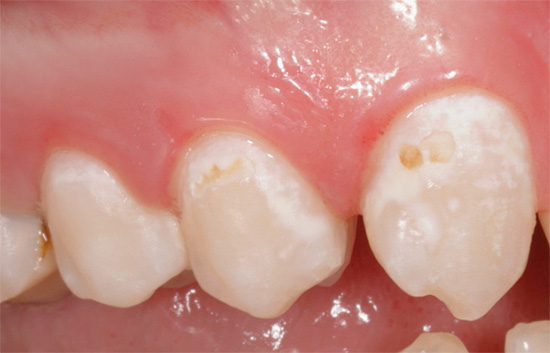
We all want to have beautiful and healthy teeth. In order for them to remain so, it is important to be able to recognize the signs of initial caries in time in order to take adequate measures to prevent its further development.
Even if you go to the dentist every six months to see you, it is far from a fact that during this time the carious process from its initial form, for example, from the white spot stage, will not have time to develop further, affecting the dentin of the tooth. Then dental treatment without the use of a drill is unlikely to be avoided.
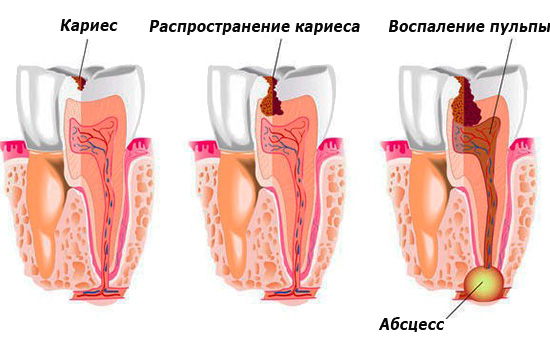
So, if you notice suspicious white spots on your teeth, and especially brownish or even almost black, and periodically there is a mouthblow (tartness or astringent aftertaste) in the mouth - it is highly likely that caries has already begun its destructive work on enamel your teeth.
What is the initial caries and its causes
For a better understanding of what initial caries is and why it occurs, let's recall the structure of the tooth. Namely - that the topmost and most durable part of it is enamel. If oral hygiene is unsatisfactory, as a result of the vital activity of microorganisms in the mouth organic acids are formed from carbohydrates (primarily from sugar), and plaque forms on the surface of the enamel.
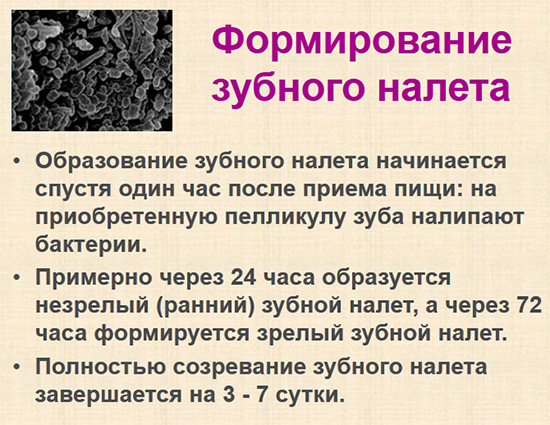
The tooth enamel consists of compounds of calcium, phosphorus and fluorine, as well as a protein matrix, which, like a mesh, penetrates the entire structure. With prolonged exposure of the enamel to acids, mineral components are washed out of it - this process is called enamel demineralization and is the main cause of initial caries.
As a result, white cretaceous spots appear on the surface of the teeth - demineralization sites. The initial caries at this stage is also called caries in the white spot stage. At the same time, the enamel of the tooth looks still smooth, but already loses luster, its hardness in such areas somewhat decreases, it becomes more porous (see photo):
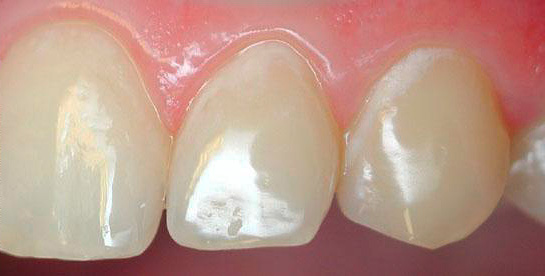
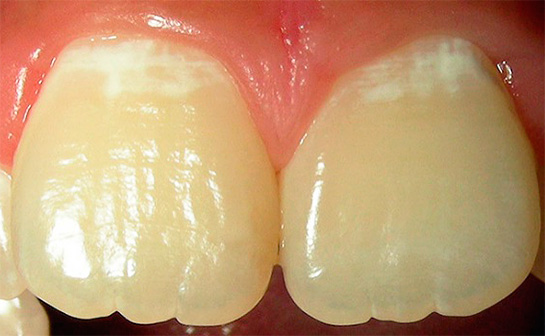
It is interesting
The enamel demineralization at the initial stages of the carious process is reversible.Numerous experimental and clinical studies have shown that the crystal structure of enamel can be successfully restored due to the intake of mineral components from outside — first of all, calcium, phosphorus and fluorine compounds. However, such remineralization is possible only with a certain degree of destruction of hard tissue.
The limit that determines the possibility of such a remineralizing treatment is the safety of the protein matrix of enamel. If the protein matrix has not yet managed to collapse during the initial caries, then due to its inherent features, it is able to absorb calcium ions and phosphate ions from the outside, which eventually crystallize in its structure with the restoration of the protective properties and hardness of enamel.
The initial caries in the stage of white spots is especially noticeable on the front upper and lower teeth: it is enough to stand in front of the mirror and slightly dry the surface of the tooth. Demineralization sites appear as white spots (the so-called white caries). However, it is quite obvious that the pathological process is far from being limited in its localization by the front teeth; it can occur on almost any tooth and on any of its surfaces.
Dentist tells:
“It should be noted that white spots on the enamel can also indicate non-carious lesion (for example, enamel hypoplasia). Is it worth while to worry, looking at such sites? I do not know, but personally I have a white spot on one tooth, which I noticed about 5-7 years ago in front of a mirror. Before that, I did not notice, but for the first time I really panicked, looking at the area of the change in the upper lateral incisor. I didn’t do anything, but after the time I realized that it was hypoplasia - enamel underdevelopment from childhood.
So, as I did, it is better not to do. Then I imagined clearly that such stains could not be caries and were not reinsured in the dentist’s chair. Having initial knowledge on this issue, I made the correct preliminary diagnosis in absentia and I was not mistaken. ”
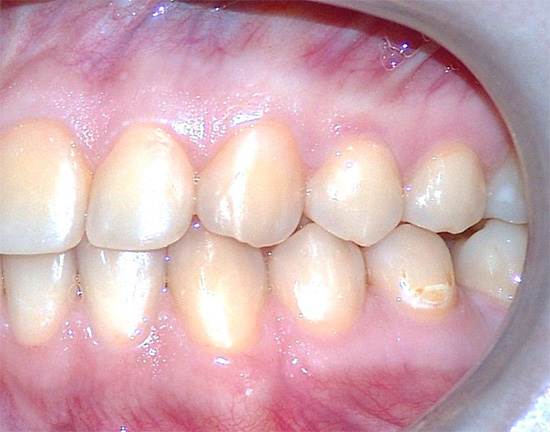
The increased porosity of the demineralized areas of enamel leads to the fact that the initial caries from the stage of the white spot rather quickly passes into the stage of the dark spot. Carious fabrics at the same time are pigmented by various dyes and acquire shades from light brown to dark brown, almost black.
However, let's talk about the clinical manifestations of the initial caries in more detail, since it is important to be able to recognize the problem at the initial stages of its appearance in order to take action in time.
Clinical manifestations of pathology
It is believed that with the initial caries, the standard symptom is the periodic sensation by the person of the mouthwash feeling that occurs when the teeth hit sour, sweet or salty foods. In this case, strong pain, as in the case of dentin caries (the main tooth tissue under the enamel), does not occur, and this is a peculiar treachery of the initial caries - a person can walk with him for a long time without even knowing that the enamel his teeth are gradually destroyed.
However, in practice, patients do not always complain about the sense of mouthwash, especially in the early stages of the initial caries.
On a note
Tooth enamel is devoid of nerve endings and consists of almost 97% inorganic substances. The thickness of the enamel in different parts of the tooth varies significantly, almost fading away at the neck of the tooth. Accordingly, the strong pain in caries will be felt only when the carious process gets through the enamel below, to the dentin, penetrated by microscopic canaliculi with nerve endings.
However, the sensitivity of teeth can be caused not only by the appearance of demineralization zones,but also increased erasability of enamel (when brushing teeth and pressing the brush in the cervical areas), as well as a banal violation of the density (or structure) of enamel, when without the appearance of initial caries a process of “conductivity” of cold and hot from enamel into deep tissues occurs.
The enamel itself, of course, has no nerve endings, and its structure changes constantly, even without initial carious zones. However, it is enough for some people to press excessively on the cervical areas with a toothbrush for a couple of days in order to be afraid to touch sensitive areas for the next 2-3 days.
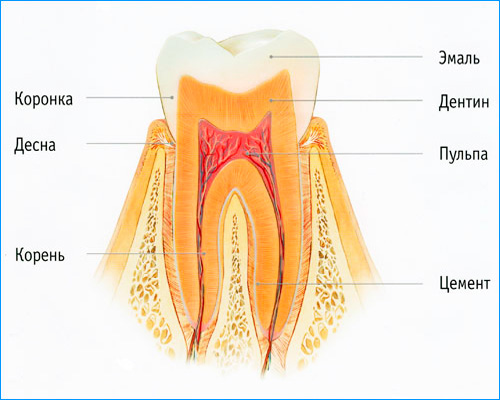
The clinical manifestations of the initial caries include a change in the color of the tooth, as already mentioned above. The following shades are observed as the pathological process develops:
- natural tooth shade, but matte;
- white;
- beige;
- light brown;
- dark brown;
- the black.
You may be surprised, but the black dots or stripes on the teeth in the fissure area (the natural topography of the tooth surface) still do not indicate that the tooth is irreparably rotten and everything is very bad with it.There are really problems with it, but this condition may well be one of the clinical manifestations of initial caries. And he, as you remember, may in some cases be completely reversible.
The photo below shows approximately the initial caries in the fissure of the tooth:
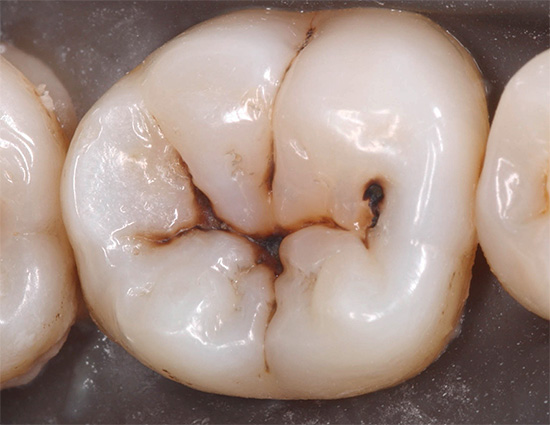
From the point of view of a professional dentist, the clinical picture of the initial caries is complemented by a number of significant nuances. For example, the doctor will definitely check the state of the enamel using a dental probe - during the initial caries in the white spot stage, the tip should slide over the surface, since the enamel still retains a rather high hardness.
With a deeper process of demineralization, probing may reveal some roughness, reduced hardness. The patient may feel a slight pain.
Methods for diagnosing initial caries
There are several widely used methods for the diagnosis of initial caries, which allow sufficiently reliably differentiate it from other pathological conditions of the teeth. The simplest of them is the above-mentioned drying of tooth enamel.Demineralization sites at the same time look dull, often whitish (loss of luster of enamel is a characteristic sign of initial caries).
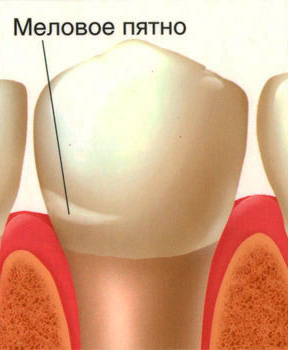
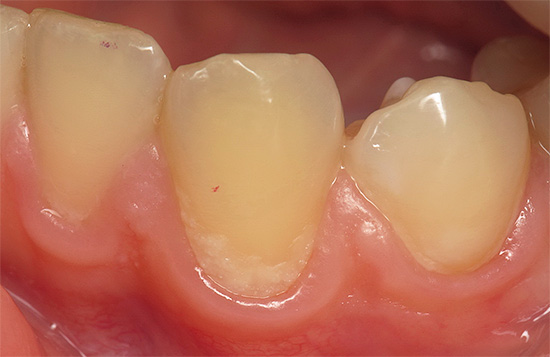
When dark spots are located in the fissures, it can be quite difficult for the doctor to determine whether this is really the initial caries, or whether it is its more profound form. Diagnosis in children in such cases is especially problematic, since the tooth enamel in the fissure area is often not sufficiently mineralized, and pain sensation can occur even on intact (not involved in the carious process) tooth surfaces. Many reputable children's dentists generally prohibit the use of sharp probes (and probes in general) for diagnosing fissure caries in children with unformed enamel due to the fact that:
- The probe injures the enamel;
- The probe can begin to get stuck even in normal fissure, creating artificial pockets of enamel "roughness".
A very effective method for diagnosing initial caries is the use of various dyes, which, due to the increased permeability of demineralized enamel, are able to penetrate into its depth and firmly fixed in the pores.The most commonly used organic dyes include:
- methylene blue (2% solution in water);
- methylene red (0.1% solution in water);
- tropeolin;
- carmine;
and others. The diagnostic procedure begins with the isolation of the tooth from the saliva with the help of cotton rollers and its subsequent drying. Then a little dye solution is applied to the enamel surface with a cotton ball and wait a few minutes in order for the dye to consolidate in the enamel pores, if any. Then stained areas of the tooth are washed with water. A sign of the initial caries will be persistent staining of enamel in the color of the used dye.
The photograph clearly shows the areas of demineralized enamel stained with dye:
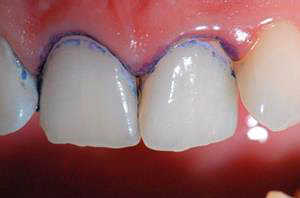
A method of staining demineralization sites using an aqueous solution of silver nitrate has also been proposed. At the same time, silver ions are restored in the pores to metallic silver, which gives enamel a black color. The disadvantage of the method is the irreversibility of such a color.
On a note
In progress differential diagnosis of initial caries the dentist should also ensure that white spots on the teeth are not signs of endemic fluorosis associated with an excess of fluoride in the body.Carious stain is usually single, and fluorotic spots, as a rule, are multiple and are often located symmetrically on the teeth of the left and right side of the same name. It is also taken into account that the initial caries is usually localized on the approximate surfaces of the crowns of the teeth, in the area of the necks and fissures, being found in people who are generally prone to caries and having other signs of it. Fluorous spots are often formed on the canines, as well as on the incisors - that is, on the teeth that are most resistant to caries.
The doctor also takes into account the endemicity of the area by disease. This means that in areas with a high content of fluoride in drinking water endemic fluorosis is common and, accordingly, to the doctor - a hint. Most of the regions (perhaps more than 90%) in Russia are low in fluorine in drinking water, so sometimes it’s enough to look in the medical card if the patient is a visitor who comes with multiple stains on the teeth.
Diagnosis in case of suspicion of fluorosis can be carried out using a dye solution, as only carious areas will stain.
The following photo shows examples of fluorosis:
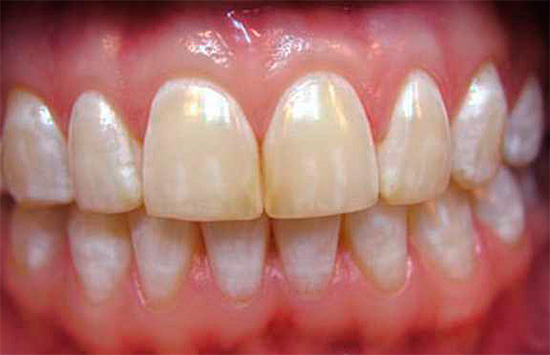
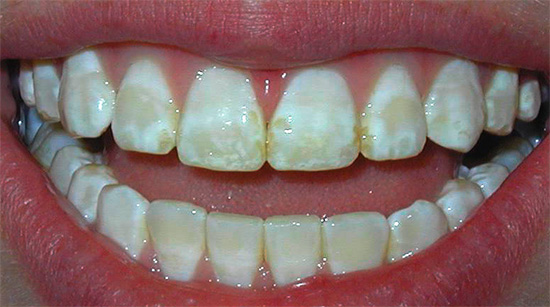
It should also be borne in mind that the presence of whitish spots on the teeth in children may be a sign of enamel hypoplasia, that is, its insufficient development, usually associated with metabolic disorders at the stage of the fetus. In hypoplasia, the enamel as a whole is thinned, there are white glassy spots, which encircle the crown of the tooth in the form of tracks. Such stains are not stained with dye, which makes it possible to reliably distinguish them from white spots characteristic of the initial caries.
Treatment of initial caries at the dentist
The main approach in the treatment of initial caries is to try to restore the properties of tooth enamel by remineralizing it with calcium, phosphorus and fluorine preparations. In other words, it is necessary to saturate the enamel with those minerals that it lost during the carious process, and such treatment can be carried out using conservative methods, without using a drill and drilling out the affected tooth areas.
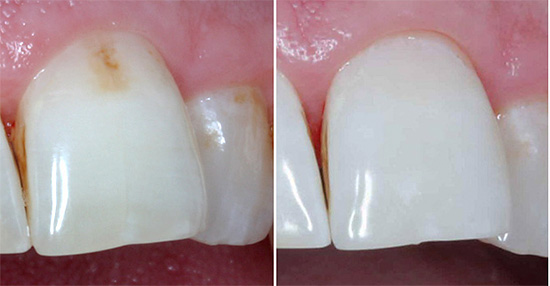
Given that dental plaque, mild plaque and dental plaque prevent the flow of minerals into the enamel, the doctor will first of all conduct professional oral hygiene.In addition to the removal of plaque and stone, the surfaces of all teeth, fillings and orthopedic structures will also be ground.
Then follows the stage of the actual remineralizing therapy, during which the initial caries is treated with calcium, phosphorus and fluorine. With the help of them is achieved tens and hundreds of times higher concentration of the necessary chemical elements, compared with their content in saliva. As a result, the processes of diffusion of substances into the tissues affected by caries proceed much faster, which allows you to complete the treatment in just 10-20 procedures.
It is interesting
Frequently, fluorine is included in the composition of the means used for remineralizing therapy in the treatment of initial caries. It is established that this trace element significantly accelerates the deposition of calcium in the protein matrix of tooth enamel, in general, increasing its resistance to the effects of acids. This becomes quite understandable if we recall that the basis of enamel is a chemically very inert mineral, fluorapatite.
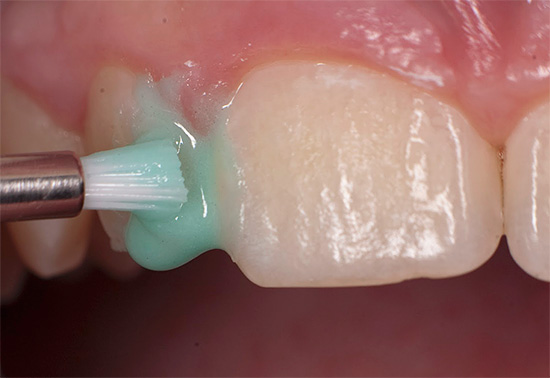
The following variants of enamel restoration methods are possible:
- the surface of the teeth is mechanically cleaned of plaque with an abrasive toothpaste.Then it is treated with a weak solution of hydrogen peroxide, dried, the affected areas are treated for 20 minutes with a 10% solution of calcium gluconate, and then make lotions with a 2-4% solution of sodium fluoride for approximately 5 minutes. To get rid of white or slightly pigmented carious spots usually 15-20 such procedures are usually performed every other day or once a day. With initial changes, the healing effect becomes noticeable almost immediately. However, today this method of Borovsky-Leus is increasingly being rejected because of the toxicity of the solutions used: working with such concentrations of fluoride is risky.
- Another option is possible when a special slightly heated gel containing about 2% sodium fluoride and 3% agar-agar is applied to the teeth after their preliminary cleaning with toothpaste. The gel quickly hardens on the teeth to form a film. Usually, 5 applications are enough for treatment. The disadvantage of the technique, as in the previously described, is the use of high concentration fluorides.
- Sometimes drugs used to treat initial caries may not contain fluoride at all, based only on calcium salts and phosphates (for example, Remodent, calcium phosphate-containing gels, etc.)
In some cases, the course of treatment is completed by covering all teeth with a special fluorine-containing varnish (fluorine). In addition, the doctor teaches the patient the rules of oral hygiene, explaining exactly how to monitor your teeth so that caries does not appear.
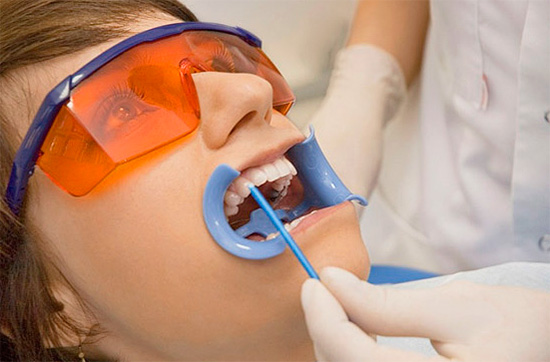
In pediatric dentistry, for example, the following drugs are used today for the treatment of initial caries:
- Gluftored;
- Enamel-sealing liquid;
- Belagel Ca / P, Belagel F.
Periodic monitoring of the condition of teeth treated from initial caries is also important. It is recommended to visit the dentist no later than 3 months after the course of remineralizing therapy.
Referring to the dentist for treatment at a stage when caries is already characterized by the presence of almost black pigmented areas on the teeth, it is important to understand that in such cases remineralization will not always help. As a result, the affected surface will be either drilled and sealed, or, in a favorable case, ground with subsequent remineralizing therapy.
From the practice of the dentist
Most often, the damage of enamel in the form of caries in the staining stage occurs in children. This is due to the weak mineralization of enamel and its not final formation at a particular age. It is observed that in children with multiple white spots on the teeth, the intensity of caries is higher. This is a rapidly ongoing form of demineralization, which requires immediately initiated remineralization therapy to prevent the transition of the carious process to another stage.
According to some authors, pigmented carious spots found in large quantities in a child require routine treatment (with a favorable prognosis for the effectiveness of remineralizing drugs).
How to treat caries in the stage of white spots at home
If there are signs of initial caries, the best option would be to contact a dentist who will conduct the treatment effectively and efficiently. However, at home, a certain positive effect with the right approach is also quite possible.
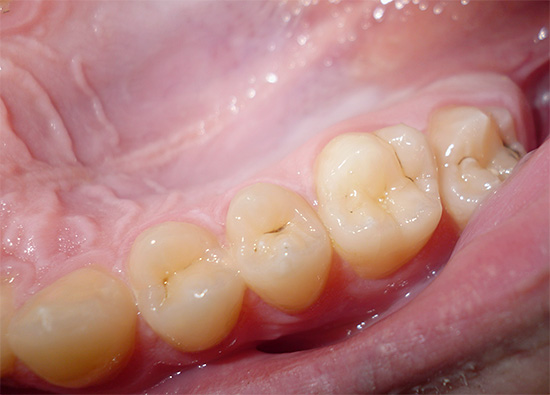
In fact, the task is to independently conduct remineralizing therapy with the help of available drugs. For this you can, for example, use:
- Remineralizing gel ROCS Medical Minerals (Roks Medical Minerals) based on compounds of calcium, phosphorus and magnesium. The gel does not contain fluoride, so it is safe if swallowed. It removes the increased sensitivity of teeth and is effective for the treatment of caries in the stage of white spots. When the teeth are applied to the mineral components, they gradually penetrate into the enamel, thereby restoring its structure.
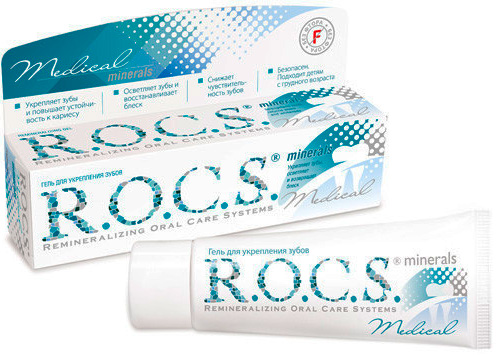
- Elmex gel (Elmex, Germany). Enough effective fluoride-containing gel for the treatment of teeth with a content of fluoride ions in a concentration of 12,500 ppm (1.25%). This is a fairly high concentration, so swallowing the gel should be avoided, especially in children. For a pronounced remineralizing effect, it is enough to apply the gel on the teeth (brush their teeth) at least 2 times a week for 2 minutes.
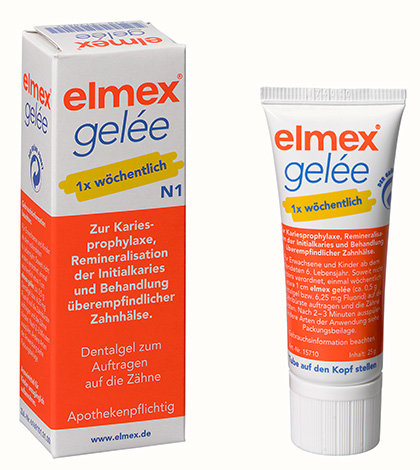
- Amazing White Minerals teeth remineralis gel. Especially good effect is achieved after professional hygiene of the oral cavity, but even without it, the gel is quite suitable for stopping the development of caries in the stage of white spot.

There are a number of other means for the treatment and prevention of initial caries, and this includes toothpastes with fluoride content. Especially pronounced therapeutic effect can be obtained with proper combination of calcium and phosphorus-containing drugs (for example, in the morning) with fluorine-containing (in the evening).However, to carry out the procedure of treatment at home as efficiently and safely as possible, consult with your doctor.
Prevention of initial caries
Being well aware of the reasons that lead to the appearance of initial caries (enamel demineralization under the action of acids), preventive measures are quite obvious and will prevent it.
Perhaps the most effective way to prevent the development of caries is regular and proper oral hygiene. If you brush your teeth 2 times a day and think that this is enough, then you are mistaken.
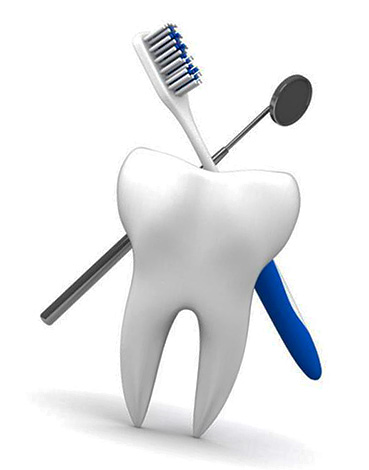
Important
Carious microorganisms are able to lower the pH in the oral cavity 10-20 minutes after ingestion of sugar-containing food. So, if you do not rinse your mouth after eating, after 20 minutes the tooth enamel begins to undergo the ravages of acids.
Proper use of dental floss, chewing gum after eating, competent choice of toothpaste and toothbrush - all this also requires attention as part of the prevention of carious processes.
In general, preventive measures are divided into exogenous, which we have already partially affected, and endogenous - these are general prevention methods associated with exposure to the body from the inside.This includes the general strengthening of the immune system, the consumption of a sufficient amount of vitamins, a balanced diet, reduction of the impact of stress factors, taking fluorine, calcium, etc.
Note also some exogenous methods of caries prevention:
- sealing fissure teeth
- professional oral hygiene and proper dental care skills
- preventive remineralization therapy
and etc.
Paying due attention to measures to prevent caries can reduce the risk of its occurrence at any age. It's never too late to start, so start taking care of your teeth today.
Useful video: the causes of initial caries and its treatment at the stage of the stain
How to properly brush your teeth

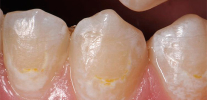
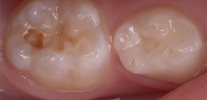
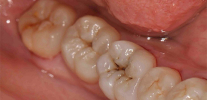
Great article, without water, with accuracy!
Very useful article! Often these dentists tell me that the dentist says that there is nothing terrible, but I tell her: “No, look, I have a terrible caries, I have already devoured the whole tooth!”)) And this fluoride mint-flavored gel that covers teeth after a professional . cleaning - the most pleasant thing that can be at the reception at the dentist)